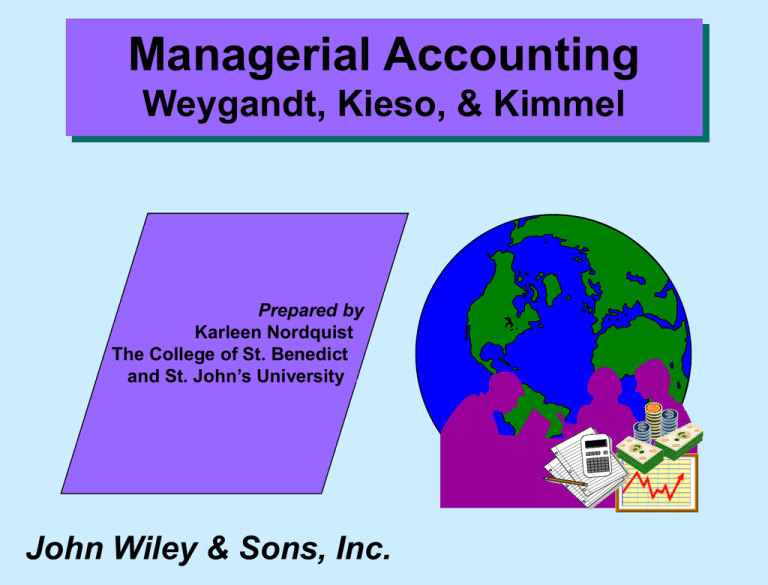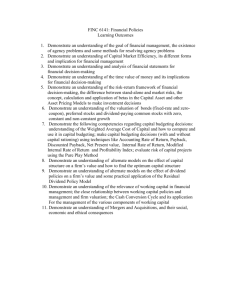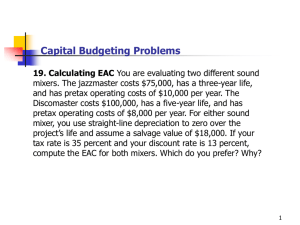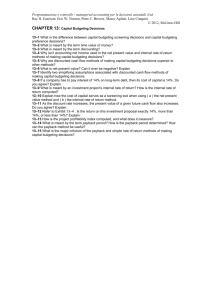
Managerial Accounting
Weygandt, Kieso, & Kimmel
Prepared by
Karleen Nordquist..
The College of St. Benedict...
and St. John’s University....
John Wiley & Sons, Inc.
Chapter 10
Capital Budgeting
Chapter 10
Capital Budgeting
After studying this chapter, you should be able to:
1 Discuss the capital budgeting evaluation process
and explain what inputs are used in capital
budgeting.
2 Describe the cash payback technique.
3 Explain the net present value method.
4 Identify the challenges presented by intangible
benefits in capital budgeting.
Chapter 10
Capital Budgeting
After studying this chapter, you should be able to:
5
6
7
8
Describe the profitability index.
Indicate the benefits of performing a post-audit.
Explain the internal rate of return method.
Describe the annual rate of return method.
Preview of Chapter 10
Capital Budgeting Evaluation
Process
• Cash Flow Information
• Illustrative Data
CAPITAL
BUDGETING
Cash Payback
Net Present Value Method
• Equal Cash Flows
• Unequal Cash Flows
• Choosing a Discount Rate
• Simplifying Assumptions
• Comprehensive Example
Preview of Chapter 10
Additional Considerations
• Intangible Benefits
• Mutually Exclusive Projects
• Risk Analysis
• Post-audit of Projects
CAPITAL
BUDGETING
Other Capital Budgeting
Techniques
• Internal Rate of Return
• Comparing Discounted Cash
Flow Methods
• Annual Rate of Return
Capital Budgeting
The process of making capital expenditure
decisions is known as capital budgeting.
Capital budgeting involves choosing among
various capital projects to find one(s) that
will maximize a company’s return on its
financial investment.
Study Objective 1
Discuss the capital budgeting
evaluation process, and explain what
inputs are used in capital budgeting.
The Capital Budgeting
Evaluation Process
Many companies follow a carefully prescribed
process in capital budgeting. The process
usually includes the following steps:
1 Project proposals are requested from
departments, plants, and authorized personnel.
2 Proposals are screened by a capital budget
committee.
3 Officers determine which projects are worthy of
funding.
4 Board of directors approves capital budget.
Cash Flow Information
Most capital budgeting decision methods
employ cash flow numbers rather than
accrual accounting revenues and expenses.
Revenues and expenses often differ
significantly from cash inflow and outflows.
Although accrual accounting has its
advantages over cash-basis accounting, for
purposes of capital budgeting, estimated
cash inflows and outflows are preferred as
inputs into capital budgeting decision tools.
Capital Budgeting
Considerations
The capital budgeting decision, under any
technique, depends in part on a variety of
considerations:
The availability of funds
The relationships among proposed projects
The company’s basic decision-making
approach
The risk associated with a particular project
Illustrative Data
The following data will be used in a continuing example.
This will allow for comparison of the results of the various
capital budgeting techniques.
Stewart Soup Company is considering an investment of $130,000
in new equipment. The new equipment is expected to last 10
years and have a zero salvage value at the end of its useful life.
The annual cash inflows are $200,000, and the annual net cash
outflows are $176,000. The data are summarized below:
Initial investment
Estimated useful life
Estimated salvage value
Estimated annual cash flows
Cash inflow from customers
Cash outflows for operating costs
Net annual cash inflow
$130,000
10 years
-0$200,000
176,000
$ 24,000
Illustration 10-13
Study Objective 2
Describe the cash payback
technique.
Cash Payback
The cash payback technique identifies the time period
required to recover the cost of the capital investment
from the annual cash inflow produced by the
investment.
The formula for computing the cash payback period is:
Cost of Capital
Investment
Net Annual
Cash Inflow
=
Cash Payback
Period
Illustration 10-4
The shorter the payback period, the more attractive
the investment. Also, the payback period is usually
related to the estimated useful life of the asset.
Cash Payback Example
The cash payback period in the Stewart Soup example is
5.42 years, computed as follows:
$130,000 $24,000 = 5.42 years
Assume that at Stewart Soup a project is unacceptable if
the payback period is longer than 60% of the asset’s
expected useful life. Thus, this project is acceptable. The
5.42-year payback period is just over 50% of the project’s
10-year expected useful life.
Cash Payback: Advantages
and Disadvantages
The cash payback technique may be useful as
an initial screening tool. It may also be the
most critical factor in the capital budgeting
decision for a company that desires a fast
turnaround of its investment. It is easy to
compute and understand.
However, it should not normally be the only
basis for a capital budgeting decision because
it ignores the profitability of the project. It
also ignores the time value of money.
+–
Study Objective 3
Explain the net present
value method.
Discounted Cash Flow
Techniques
Capital budgeting techniques that take into
account both the time value of money and the
estimated total cash flows from an investment
are called discounted cash flow techniques.
They are generally recognized as the most
informative and best conceptual approaches to
making capital budgeting decisions.
Discounted Cash Flow
Techniques
The primary capital budgeting method that
uses discounted cash flow techniques is called
net present value.
A second method, to be discussed later, is the
internal rate of return.
Appendix C reviews the time value of money
concepts upon which these methods are based.
(All of the PV factors in the following examples come from
Appendix C.)
Net Present Value Method
Under the net present value (NPV) method, cash
inflows are discounted to their present value and then
compared with the capital outlay required by the
investment.
The difference between these two amounts is referred to
as the net present value.
The interest rate to be used in discounting the future cash
flows is the required minimum rate of return.
A proposal is acceptable when the NPV is zero or
positive.
The higher the NPV, the more attractive the investment.
Net Present Value
Decision Criteria
Present Value of
Future Cash Inflows
Less
Capital Investment
Equals
If zero or positive:
Accept
Proposal
If negative:
Net Present Value
Reject
Proposal
Illustration 10-5
Equal Annual Cash Flows
Example
Stewart’s annual cash inflows are $24,000. If we assume this
amount is uniform over the asset’s useful life, the present value
of its annual cash flows can be computed as shown:
PV at 12%
Discount factor for annuity of $1
for 10 periods
Present value of cash flows:
$24,000 x 5.65022
5.65022
$135,605
Illustration 10-6
Therefore, the analysis of the proposal by the NPV method is:
Present value of cash flows:
Capital investment
Net present value
12%
$135,605
130,000
$ 5,605
Illustration 10-7
The proposed capital expenditure is acceptable at the 12%
required rate of return because the NPV is positive.
Unequal Cash Flows
Example
When annual cash flows are unequal, it is not possible to use
annuity tables to calculate their PV. Instead tables showing the
PV of a single amount must be applied to each annual cash flow.
Illustration 10-8
Assume Stewart Soup
Assumed
Discount
Annual
Factor
PV
expects the same
Year
Cash Flows
at 12%
at 12%
aggregate cash flows
(1)
(2)
(1 x 2)
1
$ 34,000
.89286
$ 30,357
($240,000), but a
2
30,000
.79719
23,916
27,000
.71178
19,218
declining market demand 3
4
25,000
.63552
15,888
for the new product over
5
24,000
.56743
13,618
6
22,000
.50663
11,146
the life of the equipment.
7
21,000
.45235
9,499
The PV of the annual
8
20,000
.40388
8,078
9
19,000
.36061
6,852
cash flows is calculated
10
18,000
.32197
5,795
$240,000
$144,367
to the right:
Unequal Cash Flows
Example
Therefore, the analysis of the proposal by the NPV
method is:
Present value of cash flows:
Capital investment
Net present value
12%
$144,367
130,000
$ 14,367
Illustration 10-9
The proposed capital expenditure is acceptable at
the 12% required rate of return because the NPV is
positive.
Choosing a Discount Rate
In most cases, a company uses a discount rate (also known
as hurdle rate, cutoff rate, or required rate of return)
that is equal to its cost of capital, which is the rate it must
pay to obtain funds from creditors and stockholders.
The cost of capital is a weighted average of the rates paid
on borrowed funds and funds from investors in the
company’s stock.
A discount rate has two elements:
– a cost of capital element, and
– a risk element.
Companies often assume the risk element is zero.
Choosing a Discount Rate
Using an incorrect discount rate can lead to incorrect capital
budgeting decisions.
Suppose Stewart Soup’s 12% discount rate did not take
into account the fact that this project is riskier than most of
the company’s investments. Given the risk, a 15%
discount rate would have been more appropriate.
Illustration 10-10
12%
15%
As shown on the
Discount factor for annuity
right, a 15% discount for 10 periods
5.65022
5.01877
rate would cause
Present value of cash flows:
$24,000 x factor
$135,605 $120,450
Stewart to reject the Capital
investment
130,000
130,000
$ 5,605
$ (9,550)
project because of its Positive (negative) NPV
negative NPV.
Simplifying Assumptions
In the examples of the NPV method, a number of
simplifying assumptions have been made:
All cash flows come at the end of each year.
All cash flows are immediately reinvested in
another project that has a similar return.
All cash flows can be predicted with certainty.
Because these assumptions are rarely all true in the
“real world,” NPV provides estimated analysis.
Some of these assumptions are relaxed in more
advanced capital budgeting techniques.
Comprehensive Example
Best Taste Foods is considering investing in new
equipment to produce fat-free snack foods. The following
information was determined in consultation with various
company departments:
Initial investment
Cost of equipment overhaul in 5 years
Salvage value of equipment in 10 years
Cost of capital
Estimated annual cash flows:
Cash inflows received from sales
Cash outflows for cost of goods sold
Maintenance costs
Other direct operating costs
$1,000,000
$ 200,000
$ 20,000
15%
$500,000
$200,000
$ 30,000
$ 40,000
Illustration 10-11
Comprehensive Example
The computation of the net annual cash inflows for the
project is shown below:
Cash inflows received from sales
Cash outflows for cost of goods sold
Maintenance costs
Other direct operating costs
Net annual cash inflow
$500,000
(200,000)
(30,000)
(40,000)
$230,000
The computation of the NPV is as follows:
Time
Cash
15%
Event
Period
Flow
x Factor
Equipment purchase
0
$1,000,000
1.00000
Equipment overhaul
5
200,000
.49718
Net annual cash flows 1-10
230,000
5.01877
Salvage value
10
20,000
.24719
Net present value
Illustration 10-12
Illustration 10-13
Present
=
Value
$(1,00,000)
(99,436)
1,154,317
4,944
$ 59,825
Because the NPV is positive, the project should be accepted.
Study Objective 4
Identify the challenges presented by
intangible benefits in capital
budgeting.
Intangible Benefits
The NPV evaluation techniques discussed so far rely on
tangible, relatively easily quantified costs and benefits. By
ignoring intangible benefits such as increased quality or
safety or employee loyalty, capital budgeting techniques
might incorrectly eliminate projects that could be financially
beneficial to the company. To avoid rejecting projects that
should be accepted, two possible approaches are suggested:
– Calculate NPV ignoring intangible benefits and if NPV is
negative, ask if intangible benefits are worth at least the
negative NPV.
– Project rough, conservative estimates of the value of the
intangible benefits and include those in NPV calculation.
Mutually Exclusive Projects
In theory, all projects with positive NPVs should be
accepted. However, companies rarely are able to adopt all
positive-NPV proposals.
Proposals are often mutually exclusive, meaning that if the
company adopts one proposal, it would be impossible to
adopt the other proposal.
Even in cases where projects are not mutually exclusive,
mangers must often choose between various positive-NPV
projects because of limited resources.
When choosing between alternatives, it is tempting to choose
the project with the highest NPV, but the investment required
by the projects should also be considered.
Study Objective 5
Describe the profitability index.
Mutually Exclusive
Projects: Profitability Index
One relatively simple method of comparing
alternative projects that takes into account both the
size of the original investment and the discounted
cash flows is the profitability index. The
profitability index is computed with the following
formula:
Present Value
of Cash Flows
Initial
Investment
=
Profitability
Index
Illustration 10-17
Profitability Index Example
A company must choose between two mutually exclusive
projects. Each project has a 10-year life and a 12%
discount rate can be assumed. Data related to the two
projects is as shown:
Project A
Project B
Illustration 10-16
Initial investment
Net annual cash inflows
Salvage value
Net present value
$40,000
10,000
5,000
18,112
$90,000
19,000
10,000
20,574
As shown, both projects have positive NPVs. Project B’s
NPV is higher, but that project also requires more than two
times the initial investment that Project A does.
Which of the mutually exclusive projects should the
company accept?
Profitability Index Example
Data for the two projects is shown below in a slightly
altered form:
Illustration 10-18
Initial investment
Net annual cash inflows
Salvage value
Present value of cash flows:
($10,000 x 5.65022) + ($5,000 x .32197)
($19,000 x 5.65022) + ($10,000 x .32197)
Project A
$40,000
10,000
5,000
Project B
$90,000
19,000
10,000
58,112
110,574
With the data in this form, profitability indexes for the two
projects can be computed.
Profitability Index = Present Value of Cash Flows
Initial Investment
Project A
Illustration 10-19
$58,112 = 1.45
$40,000
Project B
$110,574 = 1.23
$90,000
Project A is more desirable because it has the higher
profitability index.
Risk Analysis
A simplifying assumption made by many financial
analysts is that the projected results are known with
certainty. In reality, this is seldom true.
One approach for dealing with uncertainty is
sensitivity analysis, which uses a number of
outcome estimates to get a sense of the variability
among potential returns.
The earlier example of comparing NPVs using
different discount rates was a form of sensitivity
analysis.
Study Objective 6
Indicate the benefits of performing
a post-audit.
Post-Audit of Investment
Projects
Organizations should perform a post-audit of its investment
projects after their completion. A post-audit is a thorough
evaluation of how well a project’s actual performance matches the
projections made when the project was proposed.
Post-audits, while not foolproof, are important for many reasons:
– Managers that know their estimates will eventually be compared
to actual results are more likely to submit realistic data when
making investment proposals.
– Post-audits provide a formal mechanism for helping to decide
whether existing projects should be continued.
– Post-audits can help managers improve their estimation
techniques, thereby improving the development of future
investment proposals.
Study Objective 7
Explain the internal rate of
return method.
Internal Rate of Return
Method
The internal rate of return method results in
finding the interest yield of the potential
investment.
The internal rate of return is the interest rate
that will cause the present value of the
proposed capital expenditure to equal the
present value of the expected annual cash
inflows (i.e., a NPV of zero).
Internal Rate of Return
Method
Determining the internal rate of return involves three
steps: (These steps assume that annual cash flows are equal;
an alternative method of computing the internal rate of return
must be used when cash flows are unequal.)
Tampa Company will be used as an example. Tampa
Company is considering a new project with an 8-year
estimated life, an initial cost of $249,000, and a net
annual cash inflow of $45,000.
Internal Rate of Return
Step 1: Compute the internal rate of return
factor using the following formula:
Capital
Investment
Net Annual
Cash Inflow
=
Internal Rate of
Return Factor
Illustration 10-20
Using the Tampa Company data, the internal rate
of return factor is computed as follows:
$249,000 $45,000 = 5.5333
Internal Rate of Return
Step 2: Use the factor and the present value of an
annuity of 1 table to find the internal rate of return.
For Tampa, the net annual cash inflow is expected to
continue for 8 years. Thus, it is necessary to read across
the period-8 row in the present value of an annuity table
to find the discount factor that is closest to the internal
rate of return factor.
Periods
8
5%
6.46321
6%
8%
9%
10%
11%
12%
6.20979 5.74664 5.53482 5.33493 5.14612 4.96764
15%
4.8732
The closest discount factor to 5.53333 is 5.53482, which
represents an interest rate of approximately 9%.
Internal Rate of Return
Step 3: Compare the internal rate of return to management’s
required rate of return.
The decision rule is: Accept the project when the internal
rate of return is equal to or greater than the required rate of
return, and reject the project when the internal rate of return
is less than the required rate. This decision rule is shown
graphically on the next slide.
Assuming the minimum required rate of return is 8% for
Tampa Company, the project is accepted because the 9%
internal rate of return is greater than the required rate.
Internal Rate of Return
Decision Criteria
Internal Rate of
Return
Compared to:
If equal to or
greater than:
Accept
Proposal
Minimum
Rate of Return
If less than:
Reject
Proposal
Illustration 10-21
Comparing Discounted
Cash Flow Methods
A comparison of the two discounted cash flow methods (net
present value and internal rate of return) is presented
below.
When used properly, either method will provide management
with relevant quantitative data for making capital budget
decisions.
1. Objective
2. Decision rule
Illustration 10-22
Net Present Value
Internal Rate of Return
Compute net present
Compute internal rate of
value (a dollar amount).
return (a percentage).
If net present value is
If internal rate of return is equal
zero or positive, accept
to or greater than the
the proposal; if net
minimum required rate of
present value is
return, accept the proposal;
negative, reject the
if internal rate of return is
proposal.
less than the minimum rate,
reject the proposal.
Study Objective 8
Describe the annual rate of
return method.
Annual Rate of Return
Method
The annual rate of return technique is based on accrual
accounting data. It indicates the profitability of a capital
expenditure.
Illustration 10-23
The formula is:
Expected
Annual Net
Income
Average
Investment
=
Annual Rate of
Return
The annual rate of return is compared to management’s
required minimum rate of return for investments of
similar risk.
A project is acceptable under this method if the annual
rate of return is greater than the required rate of
return.
Annual Rate of Return
Example
Assume that Reno Company is considering an investment
of $130,000 in new equipment. The new equipment is
expected to last 5 years and have zero salvage value. The
straight-line depreciation method is used for accounting
purposes. The expected annual revenues and costs of the
new product that will be produced from the investment are:
Illustration 10-24
Sales
Less: Cost and expenses
Manufacturing costs
Depreciation expense ($130,000 5)
Selling and administrative expenses
Income before income taxes
Income tax expense
Net income
$200,000
$132,000
26,000
22,000
180,000
20,000
7,000
$ 13,000
Annual Rate of Return
Example
Average investment is computed as follows:
Illustration 10-25
Average investment = Original investment + Investment at end of useful life
2
The investment at the end of the useful life is equal to the
asset’s salvage value.
For Reno, average investment is $65,000 [($130,000 + $0) 2].
The expected annual rate of return for Reno’s investment is
therefore 20%, computed as follows:
$13,000 $65,000 = 20%
Annual Rate of Return:
Advantages & Disadvantages
The principal advantages of this
method are the simplicity of its
calculation and management’s
familiarity with the accounting terms it
uses.
A major limitation is that it does not
consider the time value of money.
Also, this method relies on accrual
accounting numbers instead of actual
cash flows.
+–
Copyright
Copyright © 1999 John Wiley & Sons, Inc. All rights reserved.
Reproduction or translation of this work beyond that named in
Section 117 of the 1976 United States Copyright Act without the
express written permission of the copyright owner is unlawful.
Request for further information should be addressed to the
Permissions Department, John Wiley & Sons, Inc. The purchaser
may make back-up copies for his/her own use only and not for
distribution or resale. The Publisher assumes no responsibility for
errors, omissions, or damages, caused by the use of these programs
or from the use of the information contained herein.
Chapter 10
Capital Budgeting








